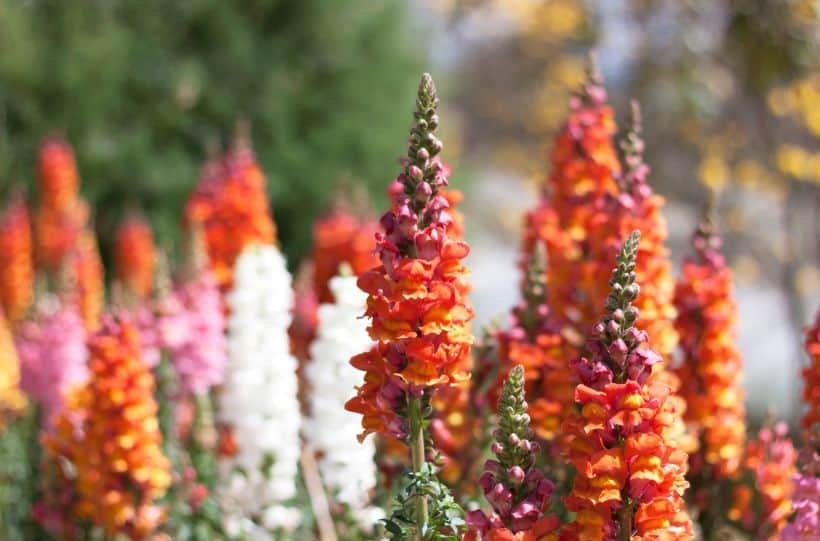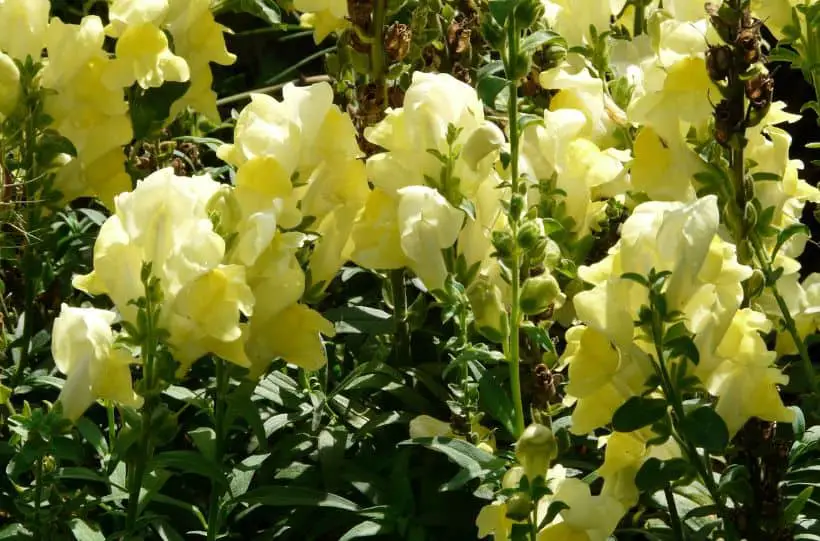How to Grow and Care for Snapdragons
Snapdragons (antirrhinum) are classic annual flowers that create beautiful foliage and also work great as cut flowers in pots or hanging baskets. Although they are perennials, snapdragons have a short blooming period.
They are easy to grow and are among the best attractors of bees and other pollinators. They thrive during the cooler (late spring to early summer) seasons of the year. Here’s a complete guide on how to grow and take care of snapdragons.

Planting Snapdragons
Snapdragons are easy to grow and once established, they do not require much care. These flowers attract pollinators and are among the flowers you must have in your garden if you are looking to attract birds and small wildlife.
Snapdragons are perhaps among the classical and oldest flowers, native to Europe and going back to the Roman Empire. They get their name from their characteristic look.
The flower heads resemble a snapdragon’s snout. When you squeeze the bottom of the buds gently, the petals open up like a mouth and close when you release the flower.
Snapdragons love the sunshine and they thrive in rich, well-drained soils.
Grow snapdragons in open places because they love exposure to the sun. They require about 6-8 hours of sunshine daily to thrive. They can also grow well in partially-shaded areas.
The soil should be slightly acidic with a pH level not exceeding 7. The best way to grow snapdragons is through transplanting.
Growing from seeds may take a long time. Purchase healthy seedlings from your local nursery. Soak the seedlings well before planting.
Add compost into the hole and mix well with the soil. At this stage, you can add fertilizer if you so desire. Ensure you have enough space between plants as snapdragons tend to grow wide. The plant’s crown should be level with the ground while planting. After planting, water deeply.
Growing Snapdragons in Containers
Snapdragons also grow well in containers. If well arranged, you can have a brilliant and colorful display of beautiful blooms in your house.
Get a large container to give the flowers enough room to grow and establish a solid root network. Keep the container in a well-lit area (preferably on a window sill or on your balcony) because the plant loves light and sunshine. Some people prefer growing snapdragons in hanging containers for decorating their patio. Ensure the soil is well-drained at all times.
Growing Snapdragons for Cut Flowers
Snapdragons make gorgeous bouquets and colorful cut flowers. When growing snapdragons for cut flowers, try growing the tall variety. Keep the stems as straight as possible. You may need to offer support to these flowers to keep the stems growing straight.

Once you cut the flowers, place the stems immediately in cool water to keep these flowers fresh for long periods.
Deadheading Snapdragons
Deadheading snapdragons will keep them blooming throughout the summer season. When deadheading, trim the leaves below the stem. This will ensure that new, healthy blooms sprout. Here are the instructions to follow when deadheading snapdragons;
- Gather all the materials you need for the job. Disinfect the scissors to ensure you do not pass any disease to your plants. The goal is to prune stems that have faded flowers, wilting petals, or ones that have started forming seeds.
- Cut off these stems from the base using sharp scissors or a knife. Remove the dead leaves as well.
- Dispose of these stalks and leaves well. If the leaves do not come from a diseased plant, you can use the matter for composting. If you suspect the plant may have been diseased, dispose of the plant matter correctly.
Snapdragon Varieties
They come in different varieties and can grow up to 36 inches tall. There are four varieties of snapdragons depending on their height;
Dwarf
These only grow to about 12 inches and are great for flower beds and rock gardens because they grow close together and form dense foliage.
Medium
These grow up to 2 feet tall and can be used as cut flowers or for foliage. Examples of medium snapdragon varieties include Tutti Frutti and Cinderella mix. Cinderella mix has orange, gold, yellow, cream, and scarlet blooms. Tutti frutti blooms are either pink, ivory, or orange.
Trailing
Trailing snapdragons grow like vines. You can find them drooping on the side of containers hanging on a patio. They are also colorful and make excellent indoor flowers. An example of a trailing snapdragon is the Candy shower variety.
Tall Snapdragons
The tallest snapdragon varieties can go up to 4 feet. These make great border flowers because they grow more stems and can intertwine easily to make wonderful foliage.
Examples of tall snapdragon varieties include Madame butterfly, topper, and Rocket.
Rocket variety can grow in warm climates because it is more heat tolerant. It has red, white, pink, and yellow blooms. Madame butterfly blooms have different color mixes as well; pink, red, yellow, rose, bronze, and ivory. Topper variety grows up to 3 feet tall and the blooms are salmon, yellow, white, or scarlet.
How to Manage Pests and Diseases in Snapdragons
Many diseases can affect snapdragons, especially if the plant is not well handled;
Downy Mildew
Symptoms: The seedling will start to curl downward and a whitish fungus substance is present on the underside of the leaves. Some plants may start yellowing or become stunted and start dying from the top. Such a plant cannot produce buds.
Control: Apply a fungicide to control the spread of the pathogen causing this disease. Control how you water the plants. If possible, do not water the plants from above so that the leaves can remain dry.
Botrytis Blight
Symptoms: There is the presence of fungal growth and the plant’s petals start turning brownish-yellow.
Control: Your plants may be planted too close reducing the air circulation. Space them out. Use a fungicide to control the spread of the pathogens that cause the disease.
Rust
Symptoms: There are yellow swellings on the leaf or stem of the plant. Once these swelling burst open, they reveal spores that contain a ‘rusty’ substance/powder.
Control: Remove the affected plant and apply fungicide to the healthy ones to control the spread of this disease.
Companion Planting
Some of the best companion plants for snapdragons that grow well with these sun-loving flowers are:
- Bleeding Hearts
- Petunia
- Roses
- Verbena
- Dianthus
- Yarrow
And for more information about growing flowers in your home garden, read these guides next:

